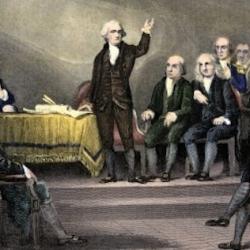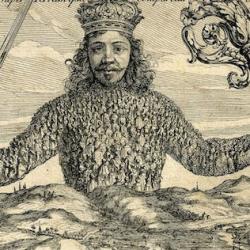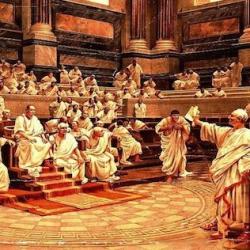Prior to the 1830s, argues JCD Clark (The Language of Liberty, 1660-1832), British political debate was carried on with denominational idioms. Political divides were denominational divides. Political and denominational issues overlapped and intertwined. Political networks, on both sides of the Atlantic, followed denominational pathways.
As Clark puts it, “From being merely the leading theme of denominational history (either an embarrassing obstacle to ecumenism or a defining myth of sectarian origins), the conflict among different persuasions of Christians is revealed as a chief determinant of the idioms of discourse within which all political conflicts were articulated. These survivals had consequences for language which in turn had political implications. If millennial eschatology survived long into the eighteenth century for colonial Americans, so too did the ancient exegetical device of typology, employed, as in past centuries, to define that vision. Typology had, indeed, been transformed since the seventeenth century ‘from a literal and historical exegesis of Scripture to an allegorical symbolism,’ but this evolution only restored to it the ‘authority of prophecy’” (146).
Denominational tonalities were replicated in political discourse: “Religious denominations, Anglican, Catholic and Protestant Dissenting, had each a particular tone or manner, immediately recognizable to ally and critic alike, which marked off these social groups from each other in the ordinary business of life. Anglican social practice mixed the sacred unashamedly with the secular in a deliberate expression of the role of the eternal in daily affairs. In the colonies as in England, divine service on Sundays produced a gathering of the community which, before and after prayers, soon turned to other things: vestry meetings, commercial transactions, sports. commercial transactions, sports. This robust attitude, underpinned by sophisticated theory about the compatibility of reason, science and attainable morality, clashed with Methodist or Dissenting attempts at other-worldliness, which Anglicans stigmatised as unchristian misery and gloom; Methodists and Dissenters responded with denunciations of Anglican impiety and profanation of the Sabbath. The lukewarmness of established religion was as much a complaint of evangelical New Lights in New England as in Anglican Virginia by the 1770s. The Gongregationalist minister William Gordon demanded rhetorically: ‘What is religion with the generality, more than being baptised, attending public worship statedly on the Lord’s day, owning the covenant, coming to the Lord’s table, and then being orderly in outward deportment!’ Anglicans, this level of formal observance would have seemed highly reassuring” (150–1).
Class and social location also overlapped with denominational ethos. There was an official Anglican social theory: “there existed from before 1662 until sometime after 1800 a coherent and widely accepted body of establishment social theory rooted in catholic ecclesiology, ultimately biblical in origin, transmitted unimpaired to the post-Reformation Church of England, and expressed most authoritatively in the Book of Common Prayer” (141). And that sort of social theory matched perfectly with the classes that dominated the church of England: “It was a ‘principal advantage of the church of England,” claimed the anonymous author, ‘that the religion which is generally practised by her members is perfectly agreeable to polite gentlemen,’ whereas the doctrines of Dissenters, taught to students, ‘make them unsociable, and unfit them for all genteel company’.” (151)
Clark argues that American discourse of independence grew from this matrix, going so far as to describe the American Revolution as a “war of religion” and a “civil war” not unlike the mid-sixteenth-century wars that preceded it.











